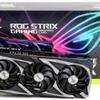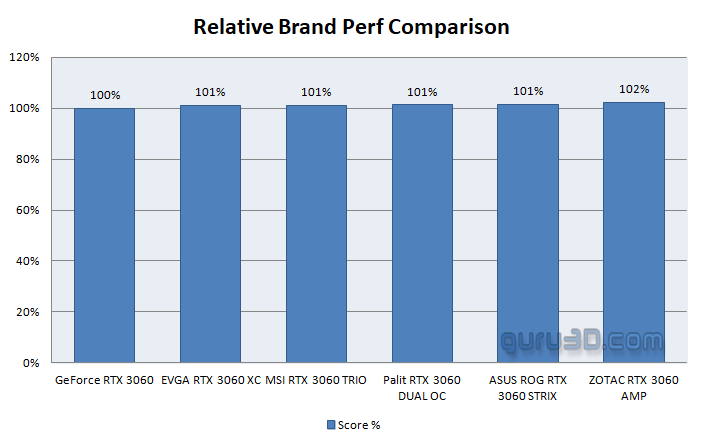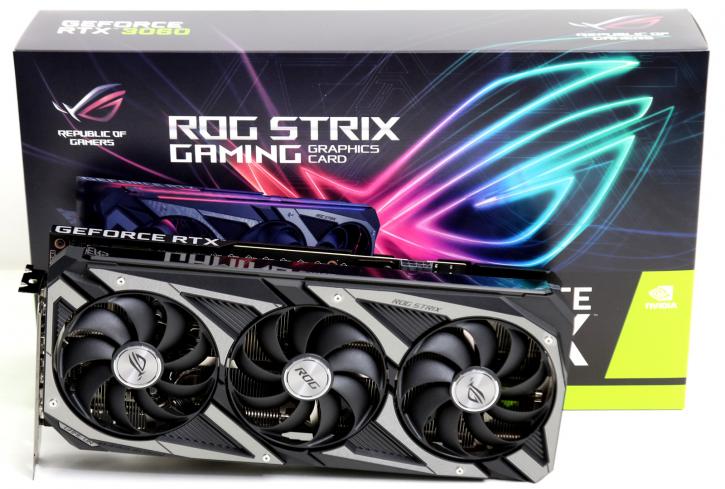Final words and conclusion
Final words
Let's talk defaults first. If only the GeForce RTX 3060 could be purchased for the advertised 329 USD, it would be an attractive product. However, we have to face the fact that the world is a place with cryptocurrency miners hogging every GPU they can get their hands on, chip shortages, and COVID, increasing the demand for home PC gaming. All these variables create a silly mix of shortages and raised prices. For the 3060 NVIDIA did implement a restriction for miners, hopefully, it'll help. The card series performance itself is decent, at best. We do want to note that the performance fluctuated quite a bit per game title. Overall I'd say the direct competitors are RTX 2070, and team Red's Radeon RX 5700 series are close in performance (though lacking DXR/DLSS/12GB). We had hopes that NVIDIA would have enabled the full shader processor stack, they didn't, and as such sometimes we feel the performance to be a little dim for something at this price level. The GeForce RTX 3060 Ti for this fact alone, absolutely would have my preference over the non-Ti mode, even with fewer graphics memory. Realistically the GeForce RTX 3060 is a product series we can still recommend if the price is right; 300 to 350 USD is steep for something with x060 in its name.
The above plot is a spread over five cards we have tested, NVIDIA did not release a reference product so the base RTX 3060 entry was simply downclocked to reference values. This however reveals a performance differential of roughly up-to 2% on a spread of games at 2560x1440. Depending on resolution and game application, you'd could hit 3% or 4% maybe. This means the (average) difference between the reference and fastest cards is roughly 2 maybe 3 FPS based on a 100 FPS average spread.
It does, however, offer performance levels in that RTX 2070 range, with the added benefit of 12 GB GDDR6 graphics memory included, and that I deem to be a sweet spot for the gamers that have a monitor with a resolution of up to 2560x1440. For some easier on the GPU gaming titles, Ultra HD as well. Once again, NVIDIA brings the advantage of DLSS, something that AMD is sorely missing on the latest 6000 series. It gives NVIDIA the resources of creating a leap in performance, as you do not need to run any form of antialiasing over the rasterizer/shading engine. That's a win any time in my book, as it's cheap extra performance. Be wary of DLSS, though; only quality DLSS 2.0 modes I deem worth it; otherwise, image corruption will be visible quite fast. Let's take Cyberpunk 2077:
Above: Ultra DLSS performance mode
Above: Quality performance mode
As you can see, there is substantial image degradation when selecting the DLSS ultra-performance mode. The grid in the back shows moire effects, also focus on the girl's shadow to the left. Also, the lettering on that metal plate behind the girl is much fuzzier. It is an incredible dilemma. Play around with the setting if you have an NVIDIA RTX graphics card and see for yourself what you deem to be acceptable. It ain't perfect, but it will free up your graphics processor, which can be used and utilized for other stuff.
The ASUS ROG STRIX GeForce RTX 3060 Gaming OC then. Of course, the card is once again a h00t, massively premium and that will mean it'll get the price tag to go along with that. Let's break it down.
Cooling & noise levels
ASUS does it well. You've seen the FLIR images; it's hardly even lighting up. You have two BIOS modes at your disposal; the performance BIOS gets this card to 57~58 Degrees C, the Silent BIOS mode to 59~60 Degrees C. Both modes offer the very same performance. Temps will vary a bit based on chassis and airflow. Acoustics wise there is only one setting to consider, silent BIOS mode, as it is just that silent. The perf mode makes little sense tbh if there isn't additional performance to gain from.
Energy
More recently, we changed the way we measure power consumption to bring you more precise numbers. Pulling manufacturer registers with, say, Afterburner creates the problem that you never know precisely what you are measuring. TGP versus TDP versus TBP. With our new methodology, we accurately measure the graphics card's power feeds, that's the PCIe PEG connectors and PCI-Slot. As such, we display the total board power. I mean, you can measure the GPU solely (TGP), but you also feed other components, like Memory, ICs, and let's not forget cooling and RGB. This card reveals a typical gaming power draw of 167 Watt during gaming.
Coil whine
The STRIX GeForce RTX 3060 exhibits hardly any coil squeal. In a closed chassis, that noise would fade away in the background. Graphics cards all make this in some form, especially at high framerates; this can be perceived.
Pricing
NVIDIA is pricing the GeForce RTX 3060 at USD 329. We have not yet received the MSRP for the gaming STRIX OC, but knowing ASUS, this product is a premium design, you may add another 100 USD. But with a predicted low availability, it's hard to really make a factual statement here if prices inflate due to e-tailers hiking up prices.
Tweaking
The graphics card is tweaked right out of the box. But can be pushed further manually. You'll reach 16 to 16.5 Gbps on the memory, a +100 MHz on the Boost, and for the lucky ones even a notch higher (that's on top of that factory tweak). Important, slide open the power limiter. More power budget allows the GPU to do what it likes to do the best, go fast. Combined with the tweaks mention on the OC page, you'll sit in the realm of ~2050 MHz on the boost frequency. The 3060 is memory bandwidth limited on that 192-bit wide memory bus, so it likes more air to breathe in. The tweak we've been able to apply was 1.735 Gbps (effective data-rate) here you'll gain a lot of extra performance. Combined with that turbo in the 2000~2075 MHz domain. Remember that values differ per workload, ASIC quality, and also the game title. For our tweak to be called valid, it needs to pass four games in a full benchmark run at WQHD to be called stable.
Conclusion
We do like the STRIX very much, it's just a beautiful maybe over-engineered graphics card with nice features, cooling, factory tweaks (for the OC model) and the ability to tweak it a notch further. It's just that pricing eh? The market really needs a card like the GeForce RTX 3060, but never has that same market been so complicated due to shortages based on the various reasons we discussed. That is what it is; we'll, as such, focus on the MSRP versus performance in the hope that in the coming months, prices will; become sane and normal again. That's said, in the 300 to 350 USD range, the price on the 3060 is a bit steep already; however, I could warrant it solely based on your framebuffer; the 12 GB GDDR6 is really nice value that will help you at least a few years. The performance does not disappoint either; I mean, roughly RTX 2070 levels are the best comparative not that I can make. If you stick to 2560x1440 as a resolution, you'll be able to play some games with Hybrid raytracing as well, and while we cannot care the slightest bit about raytraced shadows, it's the quality reflections that make the difference for me. Just drive around in London in Watch Dogs: Legion, looks at water and fire reflections in Battlefield V as an example; that's where it makes a difference. You're going to need DLSS 2.0 compatibility in games to make the best of it. But all these variables have been inserted into the RTX 3060 for you. Surely the card is not a powerhouse, but you can frag along with acceptable framerates. Back to the AIB though. An x060 series card always WAS the mainstream product, and when you look at the STRIX ... it just oozes and breathes premium. Performance-wise we cannot complain; it is RTX 2070 territory that these cards are tackling. An ongoing trend with all new technologies, of course, is an increase in graphics memory, or better yet, growing demand and thirst for it. Up-to 2560x1440, really, you're good to go with 12GB alright. The product looks nice, comes with dual-BIOS, and if you purchase the OC model, that slight bump in extra performance. The performance BIOS mode makes little sense anymore; flick that setting on silent and you retrieve the same performance with a GPU at that 60 Degrees C marker under load, in total and sheer serene silence. The card tweaked really terrific. We love the +24% on the power limiter btw. The 12GB I find to be a desirable value making this product the new sweet spot in that even more recent mid-range. ASUS has a truly breathtaking product here with this design, cooling and acoustic performance, and good tweakability.
We're very conflicted here, in one hand this is an awesome build from a hardware point of view. Hardware and design-wise it's a top pick, so we'll filter pricing OUT of the award as we cannot say anything sensible anymore about pricing with what's going on in the industry.
Sign up to receive a notification when we publish a new article.
Or go back to Guru3D's front page
- Hilbert, LOAD"*",8,1.






